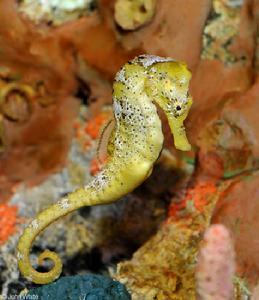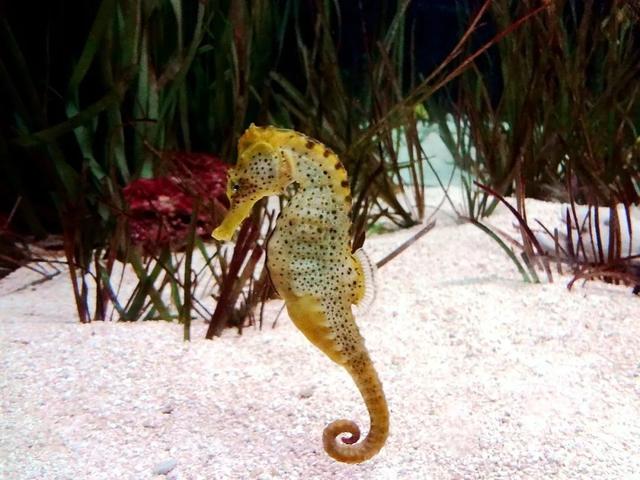
Alias Hippocampus reidi,Long-snout Seahorse、Slender Seahorse、Slender seahorse,Blunt seahorse, long snout seahorse
Family O.Acanthopanax F.Syngnathidae G.Hippocampus
Long-snout Seahorse (scientific name: Hippocampus reidi), also known as Long-snout Seahorse, Slender Seahorse, Slender seahorse, is a fish of the Syngnathidae family and the genus Hippocampus.

Long-snout Seahorse (scientific name: Hippocampus reidi), also known as Long-snout Seahorse, Slender Seahorse, Slender seahorse, is a fish of the genus Hippocampus and the genus Syngnathidae family.

Long-snout Seahorse mostly exists alone, but appears in pairs during mating. Swims primarily by rapid undulations of the dorsal and pectoral fins. The snout seahorse feeds primarily on crustaceans, with the larvae feeding on Hymenoptera, molluscs, and crustacean eggs. They do not usually chase prey, but sometimes actively pursue it. At night, the snout seahorse stops eating and swimming, wraps its tail around a grasping object, and stays there until dawn.
The snout seahorse is oviparous. Reproduction occurs year-round, but peaks are recorded from May to November in northeastern Brazil. Males are sexually mature at 9.5 cm, but do not have a mature pouch until 12.4 cm; females are sexually mature at 8.8 cm. Courtship behavior includes coloration and graceful swimming behavior in males. Has a monogamous sexual pattern.
The eggs of the snout seahorse are oval or pear-shaped, orange, and 1.2 mm in diameter. The male will incubate the young in the brood pouch before the eggs are fully hatched, and the incubation ends after about 14 days. The newly born young of the male look the same as the adult, and the height of the young is about 5.14 mm. A male snout seahorse can carry up to 1,000 young seahorses. The lifespan is estimated to be 2.5 years.
A pair of snout seahorses can be kept in a 150-liter aquarium. If the tank is large, multiple tails can be kept in groups, and they can also be mixed with milder gobies and clownfish. There must be branch-like objects in the aquarium for the snout seahorse to wrap around. Feed small crustaceans, mysid shrimp and sea catfish and other animal baits. The snout seahorse can be bred in an aquarium.
In Brazilian estuaries, the average density of snout seahorses is 0.026 samples/m2, and from 2002 to 2006, the average density in sampling sites ranged from 0.0023-0.066 samples/m2 (Rosa et al., 2007; Mai and Rosa, 2009). Lower densities were found in areas with recorded trade (average 0.013 samples/m2) than in areas without recorded trade (average 0.04 samples/m2) (Rosa et al., 2007). On the rocky coast of Rio de Janeiro State, the average density may vary between 0.001-0.04 samples/m2 (Freret Meurer and Andreata, 2008; Oliveira and Freret Meurer, 2012). In Cuba, mean densities ranged from 0.0037 to 0.01 specimens/m2 from 2004 to 2005.
Based on data from fisher surveys and data provided by government agencies in Colombia, Venezuela, and Brazil, it can be inferred that populations have declined by more than 30% throughout most of the range of the species and are continuing to decline. Populations in the Gulf of Mexico and U.S. waters appear to be stable. Overall, it is inferred that the species has experienced a population decline of nearly 30% and is continuing to decline.
The loss and degradation of some of the species' preferred habitats, particularly mangroves, due to coastal development pose a threat to the species. Being caught as bycatch in trawl and artisanal fisheries (and subsequently traded in traditional medicines or other trades), and being caught for aquarium purposes, these human causes are particularly threatening to its population.
Listed in the IUCN Red List of Threatened Species (IUCN 2016 ver 3.1) - Near Threatened (NT).
In 2004, it was listed in Appendix II of the Convention on International Trade in Endangered Species of Wild Fauna and Flora (CITES).
Protect wildlife and eliminate game.
Maintaining ecological balance is everyone's responsibility!